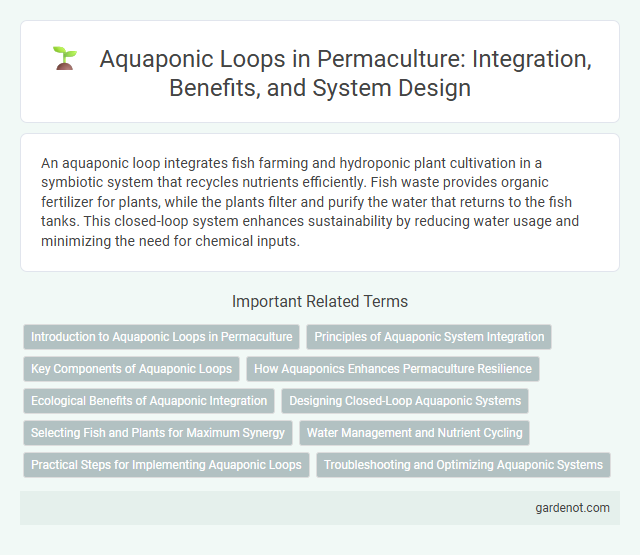An aquaponic loop integrates fish farming and hydroponic plant cultivation in a symbiotic system that recycles nutrients efficiently. Fish waste provides organic fertilizer for plants, while the plants filter and purify the water that returns to the fish tanks. This closed-loop system enhances sustainability by reducing water usage and minimizing the need for chemical inputs.
Introduction to Aquaponic Loops in Permaculture
Aquaponic loops in permaculture integrate fish farming and hydroponic plant cultivation, creating a sustainable system where fish waste supplies nutrients for plants while plants filter and purify water for fish. This closed-loop ecosystem maximizes resource efficiency, reduces water usage by up to 90%, and promotes organic food production without synthetic fertilizers. By mimicking natural ecological cycles, aquaponic loops enhance biodiversity and contribute to resilient permaculture designs.
Principles of Aquaponic System Integration
Aquaponic system integration relies on the symbiotic relationship between aquaculture and hydroponics, where fish waste provides essential nutrients for plant growth, minimizing external inputs. Key principles include maintaining water quality through microbial biofiltration, optimizing nutrient cycling, and balancing fish stocking density with plant biomass to sustain ecosystem health. Effective integration also requires precise monitoring of pH, temperature, and dissolved oxygen to ensure optimal conditions for both aquatic species and plants within the permaculture design.
Key Components of Aquaponic Loops
Key components of aquaponic loops include the fish tank, biofilter, grow beds, and sump tank, each playing a vital role in maintaining a balanced ecosystem. The fish tank houses aquatic life whose waste provides essential nutrients, while the biofilter converts ammonia into nitrates beneficial for plants. Grow beds support plant growth by absorbing these nutrients, and the sump tank regulates water flow, ensuring efficient circulation and oxygenation throughout the system.
How Aquaponics Enhances Permaculture Resilience
Aquaponics enhances permaculture resilience by creating a symbiotic loop between fish and plants, optimizing water and nutrient use while minimizing waste. This integrated system reduces reliance on external inputs, ensuring consistent food production even under changing environmental conditions. The closed-loop design promotes biodiversity and soil health, strengthening ecosystem stability and long-term sustainability.
Ecological Benefits of Aquaponic Integration
Aquaponic loops enhance ecological sustainability by combining fish farming with hydroponic plant cultivation, creating a closed-loop system that reduces water consumption by up to 90% compared to traditional agriculture. This integration minimizes chemical fertilizer runoff and decreases the environmental footprint by recycling nutrients naturally within the system. By promoting biodiversity and efficient resource use, aquaponic systems contribute significantly to resilient and sustainable permaculture practices.
Designing Closed-Loop Aquaponic Systems
Designing closed-loop aquaponic systems involves integrating fish tanks and hydroponic grow beds to create a sustainable, nutrient-efficient cycle. Key parameters include maintaining optimal water pH between 6.8-7.0, temperature ranges from 20-30degC for fish species like tilapia, and ensuring sufficient dissolved oxygen levels above 5 mg/L to promote healthy aquatic life. Effective biofiltration and continuous monitoring help recycle waste into plant nutrients, reducing water usage by up to 90% compared to traditional agriculture.
Selecting Fish and Plants for Maximum Synergy
Choosing fish species such as tilapia, trout, or catfish enhances nutrient cycling and supports robust plant growth in aquaponic systems. Selecting plants like lettuce, basil, or spinach capitalizes on their high nutrient uptake and compatibility with water conditions maintained by the fish. Balancing fish feeding rates and plant harvesting optimizes system efficiency, fostering a sustainable aquaponic loop with maximum biological synergy.
Water Management and Nutrient Cycling
Aquaponic loops optimize water management by recirculating nutrient-rich water between fish tanks and plant beds, significantly reducing water consumption compared to traditional agriculture. The system enhances nutrient cycling as fish waste provides essential nutrients for plant growth, while plants filter and purify the water before it returns to the fish. This closed-loop design ensures efficient resource use and sustainable food production within permaculture systems.
Practical Steps for Implementing Aquaponic Loops
To implement aquaponic loops effectively, start by selecting appropriate fish species such as tilapia or catfish, known for their resilience and nutrient contributions to the system. Establish a balanced ecosystem by integrating grow beds stocked with leafy greens or herbs like lettuce and basil, which thrive on the nutrient-rich water circulated from fish tanks. Regularly monitor water quality parameters, including pH, ammonia, and nitrate levels, to maintain optimal conditions for both aquatic life and plant growth, ensuring sustainable nutrient cycling within the loop.
Troubleshooting and Optimizing Aquaponic Systems
Regular monitoring of water quality parameters such as pH, ammonia, nitrite, and nitrate levels is crucial for troubleshooting imbalances in aquaponic loops. Optimizing system components like biofilters, pumps, and grow beds ensures nutrient cycling efficiency and prevents fish stress or plant nutrient deficiencies. Implementing aeration enhancements and adjusting feeding schedules can also stabilize the aquaponic ecosystem, promoting healthy fish growth and robust plant production.
Aquaponic loop Infographic

 gardenot.com
gardenot.com